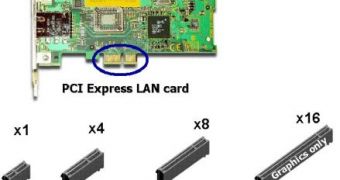The second PCI-Express standard is still far away from being used on large scale, on both laptop and desktop computer systems and already a new iteration of the internal computer communication protocol is already on the move. The PCI-SIG (the shorthand for PCI Special Interest Group) which controls the technical specifications of the standard announced the finalization of some important parts of the new PCI-Express version 3.0. According to the news site ArsTechnica the new standard will become available and will be implemented in hardware components starting with 2009 or 2010.
The main advantage of the PCI-Express version 3.0 standard over the existing PCI-Express 2.0 and PCIe 1.1 is the increased available data bandwidth that reaches to 8GT/s without the 20 percent overhead cost. Because the PCI-SIG standardization group used GT/s to measure the PCIe bandwidth and not the widely available GB/s, a maximum theoretical efficiency limit for the older standards is 80 percent. This is because the PCI-Express uses a rather special 8bit/10bit encoding system, which means that for every 8 bits of data transmitted, the hardware uses 10 bits for encoding.
Because of the 8/10 bits encoding and transmission scheme, the PCIe version 1.0 and 1.1 has a peak transfer rate of 2.5GT/s or 2Gbps, while the faster PCIe version 2.0 standard reaches 5GT/s or 4Gb/s. The new standard PCIe will extend the PCIe 2.0 transfer rate from 5GT/s to 8GT/s, but without using the same inefficient encoding mechanism, so the real bandwidth available for the hardware components will really be doubled.
As the advantages of this standard become clearer, it is possible that more and more computer hardware manufacturer companies will adopt it and replace the PCIe version 2.0. The standardization PCIe group expects PCIe version 2.0 to become popular by the end of this year and the PCIe 3.0 to start its drive to customers by 2010.

 14 DAY TRIAL //
14 DAY TRIAL //